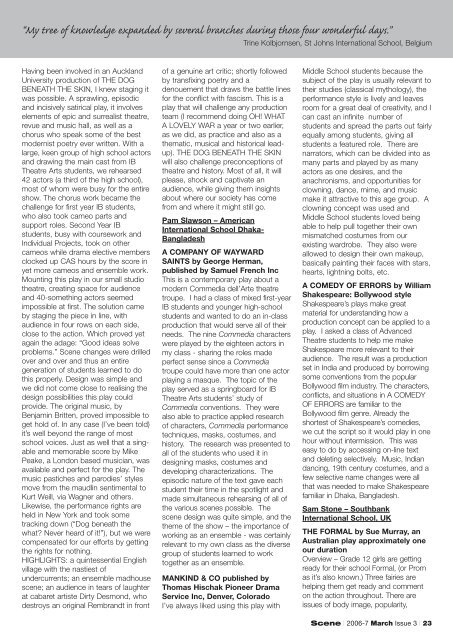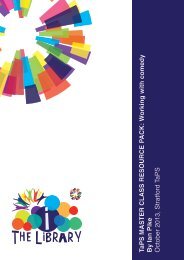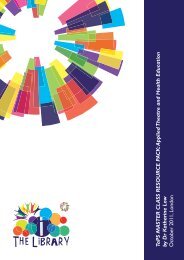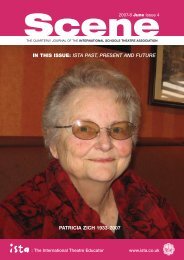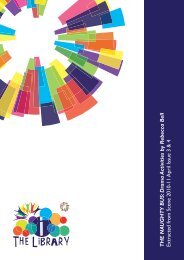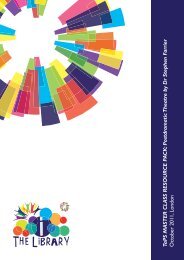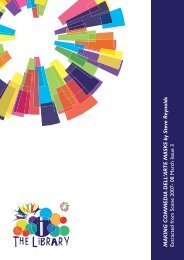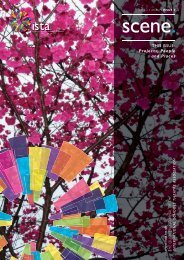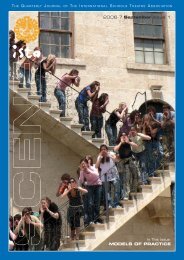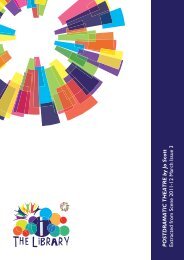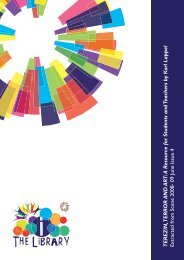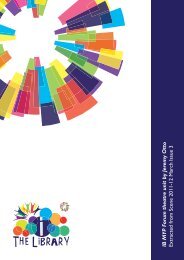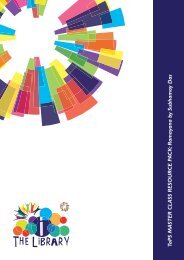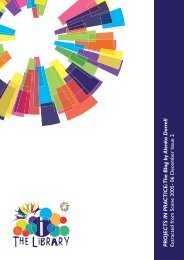ISTA/Scene March 07
ISTA/Scene March 07
ISTA/Scene March 07
Create successful ePaper yourself
Turn your PDF publications into a flip-book with our unique Google optimized e-Paper software.
“My tree of knowledge expanded by several branches during those four wonderful days.”<br />
Trine Kolbjornsen, St Johns International School, Belgium<br />
Having been involved in an Auckland<br />
University production of THE DOG<br />
BENEATH THE SKIN, I knew staging it<br />
was possible. A sprawling, episodic<br />
and incisively satirical play, it involves<br />
elements of epic and surrealist theatre,<br />
revue and music hall, as well as a<br />
chorus who speak some of the best<br />
modernist poetry ever written. With a<br />
large, keen group of high school actors<br />
and drawing the main cast from IB<br />
Theatre Arts students, we rehearsed<br />
42 actors (a third of the high school),<br />
most of whom were busy for the entire<br />
show. The chorus work became the<br />
challenge for first year IB students,<br />
who also took cameo parts and<br />
support roles. Second Year IB<br />
students, busy with coursework and<br />
Individual Projects, took on other<br />
cameos while drama elective members<br />
clocked up CAS hours by the score in<br />
yet more cameos and ensemble work.<br />
Mounting this play in our small studio<br />
theatre, creating space for audience<br />
and 40-something actors seemed<br />
impossible at first. The solution came<br />
by staging the piece in line, with<br />
audience in four rows on each side,<br />
close to the action. Which proved yet<br />
again the adage: “Good ideas solve<br />
problems.” <strong>Scene</strong> changes were drilled<br />
over and over and thus an entire<br />
generation of students learned to do<br />
this properly. Design was simple and<br />
we did not come close to realising the<br />
design possibilities this play could<br />
provide. The original music, by<br />
Benjamin Britten, proved impossible to<br />
get hold of. In any case (I’ve been told)<br />
it’s well beyond the range of most<br />
school voices. Just as well that a singable<br />
and memorable score by Mike<br />
Peake, a London based musician, was<br />
available and perfect for the play. The<br />
music pastiches and parodies’ styles<br />
move from the maudlin sentimental to<br />
Kurt Weill, via Wagner and others.<br />
Likewise, the performance rights are<br />
held in New York and took some<br />
tracking down (“Dog beneath the<br />
what Never heard of it!”), but we were<br />
compensated for our efforts by getting<br />
the rights for nothing.<br />
HIGHLIGHTS: a quintessential English<br />
village with the nastiest of<br />
undercurrents; an ensemble madhouse<br />
scene; an audience in tears of laughter<br />
at cabaret artiste Dirty Desmond, who<br />
destroys an original Rembrandt in front<br />
of a genuine art critic; shortly followed<br />
by transfixing poetry and a<br />
denouement that draws the battle lines<br />
for the conflict with fascism. This is a<br />
play that will challenge any production<br />
team (I recommend doing OH! WHAT<br />
A LOVELY WAR a year or two earlier,<br />
as we did, as practice and also as a<br />
thematic, musical and historical leadup).<br />
THE DOG BENEATH THE SKIN<br />
will also challenge preconceptions of<br />
theatre and history. Most of all, it will<br />
please, shock and captivate an<br />
audience, while giving them insights<br />
about where our society has come<br />
from and where it might still go.<br />
Pam Slawson – American<br />
International School Dhaka-<br />
Bangladesh<br />
A COMPANY OF WAYWARD<br />
SAINTS by George Herman,<br />
published by Samuel French Inc<br />
This is a contemporary play about a<br />
modern Commedia dell’Arte theatre<br />
troupe. I had a class of mixed first-year<br />
IB students and younger high-school<br />
students and wanted to do an in-class<br />
production that would serve all of their<br />
needs. The nine Commedia characters<br />
were played by the eighteen actors in<br />
my class - sharing the roles made<br />
perfect sense since a Commedia<br />
troupe could have more than one actor<br />
playing a masque. The topic of the<br />
play served as a springboard for IB<br />
Theatre Arts students’ study of<br />
Commedia conventions. They were<br />
also able to practice applied research<br />
of characters, Commedia performance<br />
techniques, masks, costumes, and<br />
history. The research was presented to<br />
all of the students who used it in<br />
designing masks, costumes and<br />
developing characterizations. The<br />
episodic nature of the text gave each<br />
student their time in the spotlight and<br />
made simultaneous rehearsing of all of<br />
the various scenes possible. The<br />
scene design was quite simple, and the<br />
theme of the show – the importance of<br />
working as an ensemble - was certainly<br />
relevant to my own class as the diverse<br />
group of students learned to work<br />
together as an ensemble.<br />
MANKIND & CO published by<br />
Thomas Hischak Pioneer Drama<br />
Service Inc, Denver, Colorado<br />
I’ve always liked using this play with<br />
Middle School students because the<br />
subject of the play is usually relevant to<br />
their studies (classical mythology), the<br />
performance style is lively and leaves<br />
room for a great deal of creativity, and I<br />
can cast an infinite number of<br />
students and spread the parts out fairly<br />
equally among students, giving all<br />
students a featured role. There are<br />
narrators, which can be divided into as<br />
many parts and played by as many<br />
actors as one desires, and the<br />
anachronisms, and opportunities for<br />
clowning, dance, mime, and music<br />
make it attractive to this age group. A<br />
clowning concept was used and<br />
Middle School students loved being<br />
able to help pull together their own<br />
mismatched costumes from our<br />
existing wardrobe. They also were<br />
allowed to design their own makeup,<br />
basically painting their faces with stars,<br />
hearts, lightning bolts, etc.<br />
A COMEDY OF ERRORS by William<br />
Shakespeare: Bollywood style<br />
Shakespeare’s plays make great<br />
material for understanding how a<br />
production concept can be applied to a<br />
play. I asked a class of Advanced<br />
Theatre students to help me make<br />
Shakespeare more relevant to their<br />
audience. The result was a production<br />
set in India and produced by borrowing<br />
some conventions from the popular<br />
Bollywood film industry. The characters,<br />
conflicts, and situations in A COMEDY<br />
OF ERRORS are familiar to the<br />
Bollywood film genre. Already the<br />
shortest of Shakespeare’s comedies,<br />
we cut the script so it would play in one<br />
hour without intermission. This was<br />
easy to do by accessing on-line text<br />
and deleting selectively. Music, Indian<br />
dancing, 19th century costumes, and a<br />
few selective name changes were all<br />
that was needed to make Shakespeare<br />
familiar in Dhaka, Bangladesh.<br />
Sam Stone – Southbank<br />
International School, UK<br />
THE FORMAL by Sue Murray, an<br />
Australian play approximately one<br />
our duration<br />
Overview – Grade 12 girls are getting<br />
ready for their school Formal, (or Prom<br />
as it’s also known.) Three fairies are<br />
helping them get ready and comment<br />
on the action throughout. There are<br />
issues of body image, popularity,<br />
<strong>Scene</strong> | 2006-7 <strong>March</strong> Issue 3 | 23


